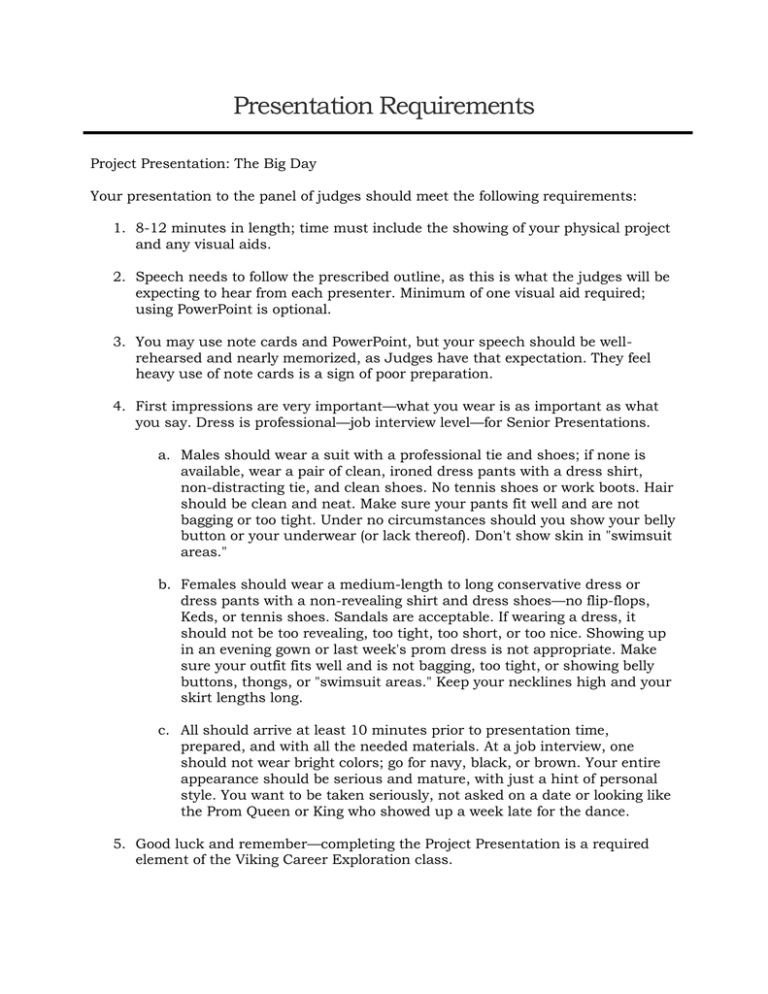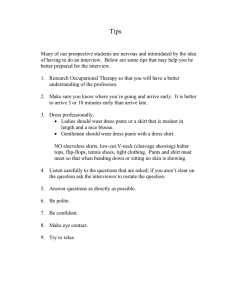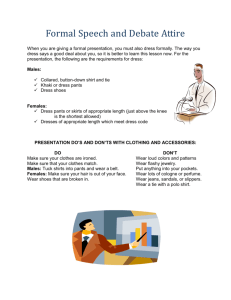Presentation require
advertisement

Presentation Requirements Project Presentation: The Big Day Your presentation to the panel of judges should meet the following requirements: 1. 8-12 minutes in length; time must include the showing of your physical project and any visual aids. 2. Speech needs to follow the prescribed outline, as this is what the judges will be expecting to hear from each presenter. Minimum of one visual aid required; using PowerPoint is optional. 3. You may use note cards and PowerPoint, but your speech should be wellrehearsed and nearly memorized, as Judges have that expectation. They feel heavy use of note cards is a sign of poor preparation. 4. First impressions are very important—what you wear is as important as what you say. Dress is professional—job interview level—for Senior Presentations. a. Males should wear a suit with a professional tie and shoes; if none is available, wear a pair of clean, ironed dress pants with a dress shirt, non-distracting tie, and clean shoes. No tennis shoes or work boots. Hair should be clean and neat. Make sure your pants fit well and are not bagging or too tight. Under no circumstances should you show your belly button or your underwear (or lack thereof). Don't show skin in "swimsuit areas." b. Females should wear a medium-length to long conservative dress or dress pants with a non-revealing shirt and dress shoes—no flip-flops, Keds, or tennis shoes. Sandals are acceptable. If wearing a dress, it should not be too revealing, too tight, too short, or too nice. Showing up in an evening gown or last week's prom dress is not appropriate. Make sure your outfit fits well and is not bagging, too tight, or showing belly buttons, thongs, or "swimsuit areas." Keep your necklines high and your skirt lengths long. c. All should arrive at least 10 minutes prior to presentation time, prepared, and with all the needed materials. At a job interview, one should not wear bright colors; go for navy, black, or brown. Your entire appearance should be serious and mature, with just a hint of personal style. You want to be taken seriously, not asked on a date or looking like the Prom Queen or King who showed up a week late for the dance. 5. Good luck and remember—completing the Project Presentation is a required element of the Viking Career Exploration class. Presentation Preparation Your Project Presentation should be the peak of your high school career (unless you caught the pass and made the winning touchdown for the state championship). Your audience will be small and supportive. You will be well prepared. This is your chance to show off and to shine. Enjoy! Visual(s) * * * * Created by you—not someone else. Professional in appearance. A project you created may serve as a visual. Photos clearly show the progress of your project, and are large enough to be seen from a distance or mounted neatly in a photo album. Captions tell the "story" of your project and give insight into what you accomplished. * Conventions are perfect. * Refer to all visuals in your presentation. * A car or other large item does not count as a visual, and should not be brought to school. Presentation Preparation * The goal of your presentation is NOT to retell your research paper to the board. * Your purpose is: to prove you are an expert on the main points of your project. to explain the process-what happened as you worked. to explain the learning-what you learned about yourself and how you changed. to show you took responsibility for your project. There are only four main areas you must discuss: * * * * your job shadows, your project, the process of doing them, what you learned about yourself. Assemble your speech from what you have already done, by getting material from: * Senior Project Proposal: the steps you followed. * Self evaluation: highlights of how you changed and what challenges you encountered. * Log of hours/Mentor verification form: general subjective and objective information. * Any interesting, unique, or exciting events or discoveries during all stages of your project. STEP 1: What are you going to talk about? Answer the following questions. (Referring to your self-evaluation forms and your journal might help.) 1. How do your job shadows and project connect? 2. What emotions did you experience as you worked through the job shadows and project? (Anger? 3. Excitement? Pride? Frustration?) 4. What problems did you encounter? (Money? Time management? Skill deficiencies?) Explain. 5. What personal growth did you gain from the job shadows and project? What self-knowledge did you gain? What knowledge of your topic did you gain? 6. How did the project affect your plans for your future? Explain. 7. What project advice would you pass on to next year's seniors? Explain STEP 2: How am I going to say this? Use the answers to the questions above as references. 1. Organization-jot your ideas on separate 3x5 cards and arrange them into an order that is logical and clear to the listeners. 2. Here are some possible organizational strategies: I. II. III. IV. Introduction Job shadow information, process, and what you learned about yourself Project information, process, and what you learned about yourself Conclusion I. II. III. IV. V. Introduction Project or paper information and process Job shadow or project information and process What you learned about yourself as you did your paper and project Conclusion * Of course, the above can be rearranged; e.g. if you want to discuss your project and what you learned before you discuss your paper, go ahead. Put your best stuff at the start and in the finish. 3. Slip blank cards into spaces where a visual aid is needed or would be appropriate. 4. Add blank cards for introduction and conclusion. If you have a project that can be displayed, jot your ideas for that display on another card, i.e., photographs. 5. Plan your introduction. The introduction should do the following: Grab attention. Make your thesis clear. (Be sure to mention both your job shadows and project). Take no more than 60 seconds. Consider using quotations, readings, dramatics, jokes, surveys or other audience participation sets, games, AV equipment, demonstrations, or questions. Memorize your introduction for a confident start. 6. Plan your transitions. What will you say to let the listeners know you are switching from paper to project? 7. Plan your conclusion. A good conclusion should do the following: Briefly restate topic/thesis. Leave the audience thinking. Take no more than 30 seconds. Memorize your conclusion so you will end with control. 8. Plan the display of your project. Will it be an on-going, integral part of your speech, such as a slide show? Part of your introduction? Happen after your conclusion? Avoid passing items around during your speech since it will distract your audience. 9. Make sure your teacher knows what AV equipment you will need. 10.Look at each idea card and fill in details, colorful anecdotes, and factual details. 11.Place all cards back in order and begin practicing your speech. Deliver your speech to your dog, to your mirror, to your friends. Practice, practice, PRACTICE! STEP 3: Speech techniques to remember: 1. Eye contact: This is extremely important. Practice often enough that you don't need any note cards or you rarely need to look at your cards. Remember this is a friendly audience. Your judges are pulling for you. You need the reinforcement that their encouraging expressions will give you. Look at them. True communication happens with the eyes. A speech without eye contact is only half a speech. 2. Posture - Stand proud. You have a right to, since you have accomplished a great deal. 3. Avoid Gripping the podium-white knuckles are so unattractive. Locking your knees -you've come too far to faint now. Twitching, wiggling, shaking, playing with hair or jewelry. 4. You want your audience to pay attention to what you are saying. 5. Voice— Be loud enough to be heard. Vary appropriately in pitch and tone. 6. Gesture - Use your hands to help make your point. Gestures should be natural and spontaneous, not choreographed and mechanical. 7. Props - Plan and practice using any props you will need. STEP 4: Prepare for questions. Of course, there is no way to know for sure what the panel members will ask you, but you can make some educated guesses and that process will provide you with the confidence and clear-headedness to take on any queries. Answer the following brainstorm questions: 1. 2. 3. 4. 5. If you were a judge listening to your speech, what would you want to know? What would you like people to ask? What unusual qualities does your project have that might spark interest? What part of your paper might make people curious? What controversial topics, if any, do you touch on?



